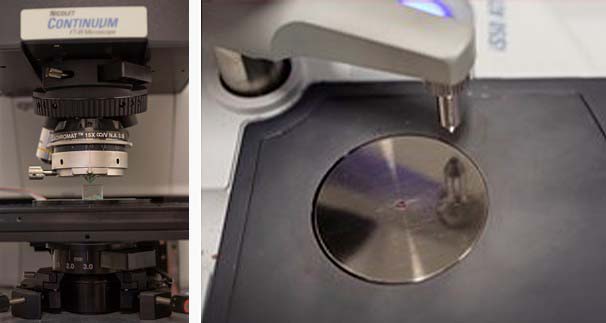The interaction of infrared radiation (IR) with the matter causes absorption of wavelengths characteristic for certain moieties. The absorption is plotted against the energy of the infrared radiation in the resulting spectrum. Interpretation of the spectrum allows both the identification of chemical groups (carbonate, sulphate, organic acids etc.), and of compounds by comparison with a database.
However, if compounds are chemically similar, it could be difficult to distinguish them only through infrared radiation. Therefore, infrared radiation spectroscopy is often coupled to other complementary techniques (e.g. Raman spectroscopy, XRD, LC/MS or GC/MS). Infrared radiation spectroscopy cannot detect single chemical elements directly.

Infrared radiation can be divided into three regions, depending of the wavelength. Each region requires a separate detector:
- Far-infrared region (20-400 cm1): compounds that are not detectable in the mid-infrared region exhibit signals in the far-infrared region, among which oxides and sulphides being the most common examples
- Mid-infrared region (400-4000 cm1): the region, which is commonly used to identify organic and inorganic compounds
- Near-infrared region (4000-40 000 cm1): this region is mostly used to study carbohydrates, e.g. wood and binding media
FTIR can be used to study both organic and inorganic materials
Typical examples of organic materials in the cultural heritage field are:
- binding media (oils, proteins, carbohydrates)
- varnishes (resins)
- supports (paper, canvas, wood)
- textile fibres
- food residuals (butter, oil, honey, wine, etc.)
- dyes
- polymers (conservation treatments, plastics, etc.)
- wood
- leather
Examples of inorganic materials include:
- pigments
- minerals
- glass
- ceramics
- mortars
- plasters
- corrosion products (e.g on metals, glass or other substrates)
Different configurations FTIR can work with
The FTIR-instrument available at SciCult-KHM is equipped to work in different configurations, depending from type of sample and research question:
- Attenuated total reflectance (ATR): this device – the most frequently used – allows the analysis of a large range of samples, from liquids to solids. The advantage is of a simple and quick measurement, but the structure of the sample is compromised.
- Transmission mode that allows bulk analysis of solid and liquid samples, both qualitatively and quantitatively. Most accurate way of measuring.
- IR microscopy used for high-resolution qualitative analysis of microsamples through transmission, reflectance, and ATR. The microscope allows automatic point analysis and area mapping. Here it is possible to keep the structure of the sample to a certain degree. Cross-sections can be investigated.
